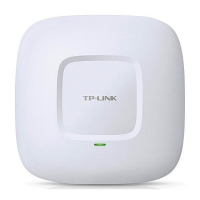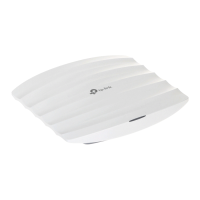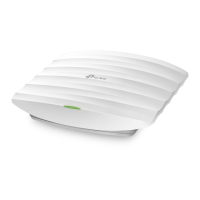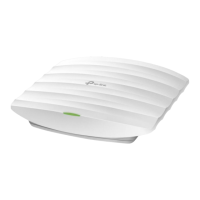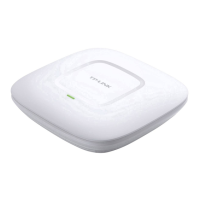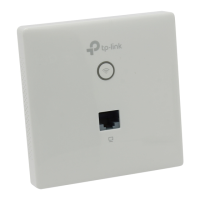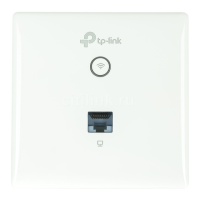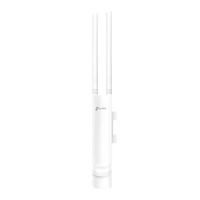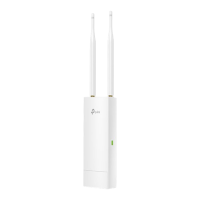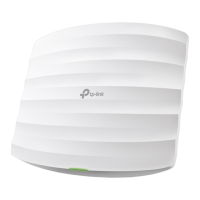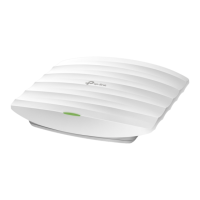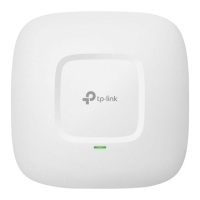Do you have a question about the TP-Link EAP120 and is the answer not in the manual?
Introduces EAP series products, features, and capabilities for small-medium businesses.
Details the physical aspects of the EAP, including top view and panel layout.
Illustrates the top view of the EAP120/EAP220, showing key components like the System LED.
Describes the interface panel components of the EAP, including ports and buttons.
Explains the structure of the mounting bracket for installing the EAP on walls or ceilings.
Guides users through setting up a wireless network connection and logging in via wireless.
Provides instructions for setting up a wired network connection and logging in via a wired connection.
Explains how to differentiate between Cluster and Standalone management modes based on web interface differences.
Details the procedures for switching an EAP between Cluster and Standalone management modes.
Centralized management and monitoring of EAPs, forming a cluster for simplified network configuration.
Displays all EAPs within a cluster, allowing configuration of private parameters for individual APs.
Describes how to switch the EAP's management mode to Cluster and configure its IP address.
Covers the configuration of static or dynamic IP addresses for the EAP device.
Manages wireless network configurations, including basic and advanced settings for EAPs.
Configures fundamental wireless parameters like wireless mode, channel width, and transmit power.
Allows creating and managing up to eight virtual wireless networks per radio with VLAN and security settings.
Adjusts advanced wireless parameters like Beacon Interval, DTIM Period, RTS, and Fragmentation.
Restricts the maximum number of clients per AP to optimize network resource utilization.
Enhances network security with authentication services for clients accessing the wireless network.
Configures portal authentication types (No Auth, Local Password, External RADIUS) and customization.
Allows clients to access network resources for free by configuring specific policies.
Controls wireless network access by filtering MAC addresses of devices.
Configures rules to automate enabling/disabling of wireless radios based on time intervals.
Prioritizes network traffic, such as voice and video, for improved quality of service.
Configures AP EDCA parameters for traffic flow from EAP to client stations.
Configures station EDCA parameters for traffic flow from clients to the EAP.
Enables and configures the Rogue AP Detection feature to identify unauthorized access points.
Enables and configures the Rogue AP Detection feature to identify unauthorized access points.
Displays a list of detected rogue access points, allowing them to be moved to the Trusted AP List.
Lists APs that are recognized as legitimate and will not be flagged as rogue.
Imports or backs up trusted AP lists, managing known legitimate access points.
Monitors the status and statistics of EAP devices, including client counts and detailed information.
Displays a list of connected APs, their MAC addresses, and the number of clients connected to each.
Monitors parameters related to wireless networks, including SSID names, VLAN IDs, and security settings.
Shows detailed information for each configured SSID, such as security mode and broadcast status.
Monitors the status of all clients connected to the EAPs, including authenticated users.
Lists all connected clients with details like MAC address, connected AP, and active time.
Displays information about clients that have successfully completed portal authentication.
Records system events, hardware/software issues, and monitors system status for failure analysis.
Provides a detailed view of system logs, including hardware, software, and system issues.
Configures how system logs are received, including auto-email, server logging, and NVRAM saving.
Manages and maintains the device through the web management interface.
Controls access to the web management page by specifying allowed MAC addresses.
Allows enabling or disabling the device's LEDs for status indication.
Enables secure remote login and management of the device via SSH client software.
Configures the device as an SNMP agent for network monitoring and management.
Manages user accounts and passwords to protect the device from unauthorized login.
Configures system time, including manual settings, NTP synchronization, and Daylight Saving Time.
Sets the system time zone, date, time, and NTP server details.
Configures Daylight Saving Time settings, including predefined, recurring, and date modes.
Restarts the device or restores it to factory default settings.
Saves current configurations to a file or restores settings from a backup file.
Updates the device's firmware to the latest version for improved functionality and security.
Introduces EAP series products, features, and capabilities for small-medium businesses.
Details the physical aspects of the EAP, including top view and panel layout.
Illustrates the top view of the EAP120/EAP220, showing key components like the System LED.
Describes the interface panel components of the EAP, including ports and buttons.
Explains the structure of the mounting bracket for installing the EAP on walls or ceilings.
Guides users through setting up a wireless network connection and logging in via wireless.
Provides instructions for setting up a wired network connection and logging in via a wired connection.
Explains how to differentiate between Cluster and Standalone management modes based on web interface differences.
Details the procedures for switching an EAP between Cluster and Standalone management modes.
Centralized management and monitoring of EAPs, forming a cluster for simplified network configuration.
Displays all EAPs within a cluster, allowing configuration of private parameters for individual APs.
Describes how to switch the EAP's management mode to Cluster and configure its IP address.
Covers the configuration of static or dynamic IP addresses for the EAP device.
Manages wireless network configurations, including basic and advanced settings for EAPs.
Configures fundamental wireless parameters like wireless mode, channel width, and transmit power.
Allows creating and managing up to eight virtual wireless networks per radio with VLAN and security settings.
Adjusts advanced wireless parameters like Beacon Interval, DTIM Period, RTS, and Fragmentation.
Restricts the maximum number of clients per AP to optimize network resource utilization.
Enhances network security with authentication services for clients accessing the wireless network.
Configures portal authentication types (No Auth, Local Password, External RADIUS) and customization.
Allows clients to access network resources for free by configuring specific policies.
Controls wireless network access by filtering MAC addresses of devices.
Configures rules to automate enabling/disabling of wireless radios based on time intervals.
Prioritizes network traffic, such as voice and video, for improved quality of service.
Configures AP EDCA parameters for traffic flow from EAP to client stations.
Configures station EDCA parameters for traffic flow from clients to the EAP.
Enables and configures the Rogue AP Detection feature to identify unauthorized access points.
Enables and configures the Rogue AP Detection feature to identify unauthorized access points.
Displays a list of detected rogue access points, allowing them to be moved to the Trusted AP List.
Lists APs that are recognized as legitimate and will not be flagged as rogue.
Imports or backs up trusted AP lists, managing known legitimate access points.
Monitors the status and statistics of EAP devices, including client counts and detailed information.
Displays a list of connected APs, their MAC addresses, and the number of clients connected to each.
Monitors parameters related to wireless networks, including SSID names, VLAN IDs, and security settings.
Shows detailed information for each configured SSID, such as security mode and broadcast status.
Monitors the status of all clients connected to the EAPs, including authenticated users.
Lists all connected clients with details like MAC address, connected AP, and active time.
Displays information about clients that have successfully completed portal authentication.
Records system events, hardware/software issues, and monitors system status for failure analysis.
Provides a detailed view of system logs, including hardware, software, and system issues.
Configures how system logs are received, including auto-email, server logging, and NVRAM saving.
Manages and maintains the device through the web management interface.
Controls access to the web management page by specifying allowed MAC addresses.
Allows enabling or disabling the device's LEDs for status indication.
Enables secure remote login and management of the device via SSH client software.
Configures the device as an SNMP agent for network monitoring and management.
Manages user accounts and passwords to protect the device from unauthorized login.
Configures system time, including manual settings, NTP synchronization, and Daylight Saving Time.
Sets the system time zone, date, time, and NTP server details.
Configures Daylight Saving Time settings, including predefined, recurring, and date modes.
Restarts the device or restores it to factory default settings.
Saves current configurations to a file or restores settings from a backup file.
Updates the device's firmware to the latest version for improved functionality and security.
| 2.4 GHz | Yes |
|---|---|
| Modulation | - |
| Frequency band | 2.4 - 2.4835 GHz |
| Number of users | - user(s) |
| Channels quantity | - channels |
| Transmitting power | 20 dBmW |
| Networking standards | IEEE 802.11b, IEEE 802.11g, IEEE 802.11n, IEEE 802.1x, IEEE 802.3af |
| Receiver sensitivity | 300M: -71dBm@10% PER\\r 150M: -75dBm@10% PER\\r 54M: -78dBm@10% PER\\r 11M: -93dBm@8% PER\\r 6M: -92dBm@10% PER\\r 1M: -96dBm@8% PER |
| Ethernet LAN data rates | 10, 100, 1000 Mbit/s |
| Maximum data transfer rate | 300 Mbit/s |
| Internal | No |
| Certification | CE, FCC, RoHS |
| Product color | White |
| Cable lock slot type | Kensington |
| Supported network protocols | Telnet |
| Ethernet LAN (RJ-45) ports | 1 |
| Security algorithms | WEP, WPA, WPA-PSK, WPA2, WPA2-PSK |
| Antenna features | Integrated antenna |
| Antennas quantity | 2 |
| Antenna gain level (max) | 4 dBi |
| Power consumption (typical) | 4.4 W |
| Storage temperature (T-T) | -40 - 70 °C |
| Operating temperature (T-T) | 0 - 40 °C |
| Storage relative humidity (H-H) | 5 - 90 % |
| Operating relative humidity (H-H) | 10 - 90 % |
| Width | 180 mm |
|---|---|
| Height | 47.5 mm |
